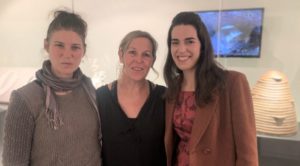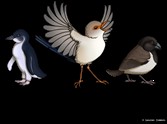
Flinders University penguin ecologist Dr Diane Colombelli-Négrel has been working with Jane Bamford, a Tasmanian artist who works with clay, to devise an ingenious innovation that will help an endangered Little Penguin colony.
Thanks to a unique union of arts, science and conservation, the Ceramic Little Penguin Nesting Module has been created for the declining population of Little Penguin (Eudyptula minor) at Emu Bay, Kangaroo Island.
“Jane has created these fantastic clay burrows that will be displayed at Emu Bay on Kangaroo Island later in the year for Little Penguins to use during their breeding season,” says Dr Colombelli-Négrel, a principal of the BirdLab at Flinders University. “The burrows will be specifically designed to reduce predation and provide Little Penguins with the best microclimate possible.”


Throughout the project, collaborative work between the artist, Flinders University, the Kangaroo Island Wildlife Network, Kangaroo Island Landscape Board and the University of Adelaide has resulted in several modifications and improvements to the design, which are ongoing – but the first nesting module template is currently being exhibited as part of the Crafted Technology exhibition (with artists Bin Dixon-Ward, Leah Heiss, Zhu Ohmu and Jess Taylor, curated by Caitlin Eyre), showing at JamFactory Gallery 2, Adelaide, until 25 July.
“I see artistic design and development of habitat support as innovative and important creative work. I believe artists are uniquely placed to transform conversations around species extinction and translate this into work,” says Ms Bamford, who is also well known for creating spawning habitat for Endangered spotted handfish on the Derwent River in Tasmania.
“I am interested in research on species extinction and also the notable and significant ‘thinning’ of species all around the globe and the factors that affect the social understanding of these events. I want to take my work into the gallery space to bring these issues to this community, and I’m interested in the way this gallery experience can subvert the community into buying work to go directly into habitat support, thus promoting philanthropy in this sector.”
Ms Bamford is encouraging buyers to purchase her work being exhibited, and then ‘gift them into habitat’ at the Emu Bay little penguin colony on Kangaroo Island. “Groups and individual are encouraged to ‘own’ this work together, and form a generous group committed to supporting innovative science and design in species support,” she says.
After the exhibition, the ceramic nesting modules will be fitted with an ibutton (to measure temperature and humidity) and installed into a colony site, to be monitored for use in moult and nesting uptake.

